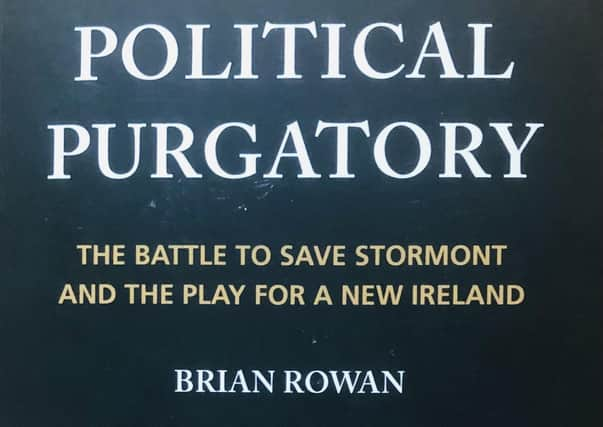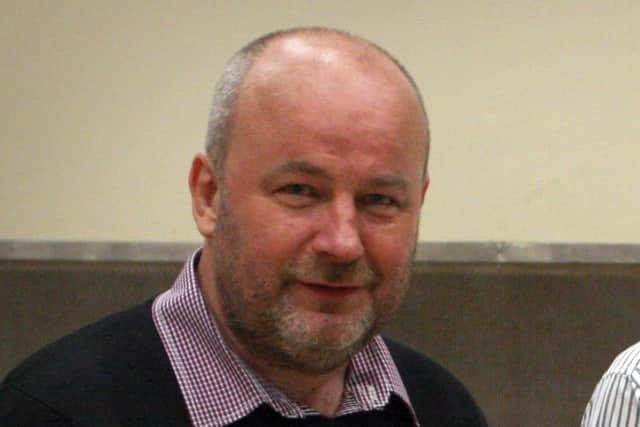Brian Rowan’s new book a forensic examination of political turmoil in NI


It’s also about the entire peace process: how it got to where it was in 2017 and why there was almost an inevitability to its collapse at that point.
A political crisis doesn’t just happen. Even in Northern Ireland. If you look closely enough, and Brian Rowan is brilliant when it comes to the forensics of local politics, you’ll see where each new hurdle appeared; even if we didn’t always know at the time that it was a potential hurdle.
Advertisement
Hide AdAdvertisement
Hide AdToo many of our politicians like to store up problems, rather than resolving them at the time. They’re good at kicking the cans down the road, or into the long grass, and then feigning surprise when they stumble over them a few months, or even a few years later.


And while our politicians store up problems, Rowan stores up the evidence of where and when those problems began. Sometimes a tweet. Sometimes a snatch of a conversation.
Sometimes an aide memorie scribbled on the back of a taxi receipt. Sometimes a quiet word with a source in a corridor at Stormont. Sometimes a more detailed conversation with a key player in a party who lets him know that there are issues capable of leading to a possible collapse. Sometimes through documents passed to him by innumerable sources. If there is evidence to be found, there’s a fair chance he’ll find it.
I remember chatting to a journalist four years ago while I waited to go into a TV studio to do some commentary. Rowan was already in the studio, explaining the choreography that had led to Martin McGuinness’s resignation letter and the plunging of the entire process into chaos. And doing it as he always did it: in a soft voice and with each comment backed up by the evidence gathered from his below the radar forensics. The journalist, who was nodding quietly as we both listened, turned to me: “This is why Barney is never surprised by events. He always seems to know when the crisis will come and always has the paper-trail in his back pocket.”
Advertisement
Hide AdAdvertisement
Hide AdThat’s the strength of Political Purgatory. Rowan takes us up to and through the last crisis step by step. He doesn’t do broad brush, big picture stuff. He hears the rustles, he observes the seeming trifles, he talks to the horses’ mouths rather than third or fourth hand sources.
More important, he joins the dots dispassionately and allows the evidence to take him to a conclusion. Others and I’m sometimes guilty of this myself, select the evidence which will steer them to where they want to go.
Another strength of this book is the input of some (there are quite a few overall) of the key players and observers.
Peter Robinson (explaining how the whole process almost collapsed after the murder of Kevin McGuigan in 2015); Sir George Hamilton (explaining the difficulties flowing from that murder, when “it became clear that there were reasonable grounds to suspect (the murder was carried out) with the knowledge and concurrence of senior figures in the republican movement”); Gerry Adams (talking about Martin McGuinness); and former secretary of state, Julian Smith (giving some useful insights into the task he faced in the few months of his tenure).
Advertisement
Hide AdAdvertisement
Hide AdI share Rowan’s quiet admiration of Smith. I know some unionists take the view that he ‘rolled over and facilitated a republican agenda’, but Smith didn’t force the DUP back into the Executive. The party could have rejected the New Decade New Approach document and fought an election. It chose not to. It chose to accept the NDNA and reboot the institutions without a resolution of many outstanding issues.
My impression of Smith is that he knew enough about Boris Johnson and his dependence on a regenerated form of English nationalism to know that he would, almost certainly, shaft both Northern Ireland and the DUP. And that’s why I think he was so keen, particularly after the DUP lost its leverage in the 2019 general election, for the Assembly to be on its feet again as quickly as possible.
Whether the DUP and SF would, in fact, have got their act together and worked more closely on Brexit issues can’t be known, because the demands placed upon them by the pandemic brought entirely new pressures.
The book would have benefited from more input by key figures within the DUP, maybe even some former special advisers, giving greater specific insight into what happened internally after the 2017 Assembly election (when unionism lost its overall majority for the first time) and after the confidence and supply arrangement with the Conservatives in June/July 2017.
Advertisement
Hide AdAdvertisement
Hide AdAnd more detail on the relationship (often quite tetchy according to some) between the MLA and MP wings of the party would have been useful. That said, the absence of their input isn’t a fatal flaw.
There’s an interesting final chapter, Centenary and uncertainty - Union versus unity, in which he considers the new challenges to the Union thrown up by Brexit. I take his points on board, but I think the debate was always coming anyway.
Brexit may have pushed it up the political agenda, but a mixture of demographics, souring relationships within the Executive and the dead hand of electoral numbers war gaming (plus Sinn Fein’s non-stop border poll campaigning) would have pushed us to this point inevitably.
But I do agree with one very particular point he makes, when he asks, “Who is best placed to sell the Union? Surely not those who were loudest in the Brexit debate and who have done to so much damage to that cause. We hear them now trying to distance themselves from that, but it is too late. (So) who, in this debate, will lead for unionism?” That’s the key question for all of unionism right now.
* Political Purgatory By Brian Rowan is published by Merrion Press (£18.99)